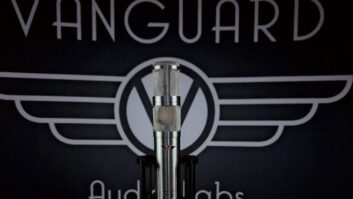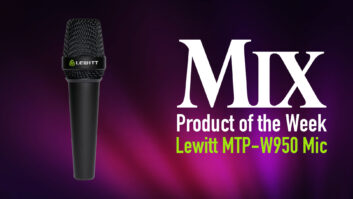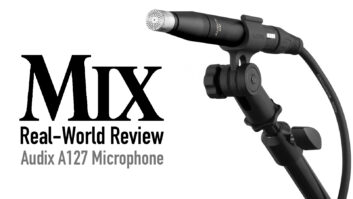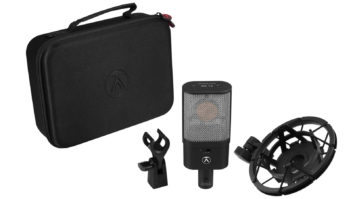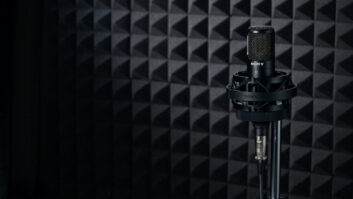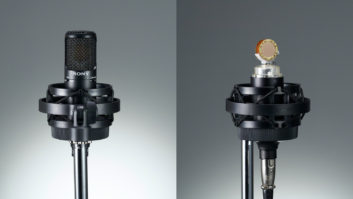Founded by David Josephson in 1989, Josephson Engineering is a boutique mic shop. Unfortunately, most engineers have never used Josephson mics — or perhaps they just don’t know that they have.
As an OEM supplier, Josephson has manufactured capsules for Manley’s Gold Reference mics and for Groove Tubes’ (pre-Alesis) Series 2 and Series 3. The company has also built instrumentation mics for Meyer Sound and SYSid Labs. Josephson keeps a low profile, which is a shame, because this small, Santa Cruz, Calif. — based company consistently offers excellent products.
I decided to check out a matched pair of Josephson C617SETs. Each mic has an all-Josephson body and a Josephson-branded Gefell MK221 half-inch diameter, 0.9-micron-thick nickel capsule. The body is based on and refined from the C606 mic; the C617SET uses improved FET front-end circuitry that is combined with a balanced, bipolar, Class-A symmetrical output stage.
Although the body requires standard 48VDC phantom powering, the mic provides full 200-volt polarization potential for the Gefell capsule. This higher voltage lets Josephson use a lab-grade measurement capsule that is noted for its accurate off-axis frequency response and a more true omni polar pattern at higher frequencies. The small nickel diaphragm can be tensioned much higher than a traditional Mylar design, providing a very fast transient response, all of which translates into very good audio.
A VERSATILE PLAYER
The C617SET is adept across a number of studio applications. For starters, I heard them on a recording of a Yamaha C5 Grand piano. The sound was well-balanced top to bottom with no high-end hype. The recording sounded as if you were in the room with the instrument — the mic is very revealing and uncolored. What you hear live is what you get with the C617SET.
For this application, the mics were placed in a spaced pair about eight inches from the hammers. At first, I tried placing the mic about two feet from the open end of the piano, but that brought too much of the room into the mix. To adjust this, the mics were moved closer over the hammers, which mixed more of the direct sound of the piano into the mix — perfect.
Next I used them as a spaced pair of overhead drum mics. They produced rich sonic detail and a beautiful stereo picture with no smear or harshness, even when the cymbals were hit hard. There was plenty of bottom end from the kick and toms, providing an accurate picture of the kit — a great feature. I was able to get most of the mix from the overheads with the tom mics used as fills. I also used them as room mics with equally good results. Once again, the mics produced a rich, balanced tone with plenty of punch in the kick.
The mics also excelled on acoustic guitar. The C617SETs were placed in an ORTF-like array about eight inches in front of the player, centered in the area between the soundhole and the place where the neck meets the body. The tone was full with plenty of definition in the high end, perfectly bringing out the sound of the pick hitting the strings. The tone was not boomy at the bottom or hyped at the top.
The mics’ uncolored nature was quite evident in this application — the guitar had dead strings that were in need of changing. Once they were switched out with new strings, the tone was much better, with the high end becoming more “in your face.” A pair of cardioid condensers put up on the same guitar during the same session hyped the high end and did not reveal this. The cardioids also had a dip in the midrange and were hands-down losers in comparison to the Josephsons.
A single C617SET was just the ticket for recording a soprano sax. I sent it through a Rupert Neve Design Portico 5012 dual mic preamp without the Silk button engaged. The mic was placed six inches in front of the horn, pointing at the keys about six inches above the bell. It tamed the usually screechy quality of the horn in the upper register, and a colleague of mine was in awe that there was not a compressor on the horn to smooth it out. It sounded like a record.
CAN YOU HANDLE IT?
The word that best describes the sound of the C617SETs is “real.” In every application, the tone was balanced — there’s plenty of body without boom and a beautifully detailed high end that was never brash, even under high SPL. The C617SET renders cymbals beautifully. At a distance in the room, it imparts a silky smoothness that you have to hear to believe. Up close, directly over the kit, the sound is once again balanced and beautiful.
No matter what I threw at this pair, I was pleasantly surprised at the outcome. However, in some applications, I did find that the mics’ “truth” hurt, telling me that, in the case of my guitar recordings, the source was in need of a string change or an altogether change of instrument.
The truth about the C617SET also hurts the budget: The C617SET body alone is $960, and with the addition of the Gefell MK221 capsule, the price goes up to $1,840. (Yes, you can choose to use another type of compatible capsule.) But isn’t the truth worth it? It’s like having a good friend in your mic locker who will always give it to you straight.
Josephson Engineering, 831/420-0888, www.josephson.com.
Kevin Becka is the technical editor of Mix.

